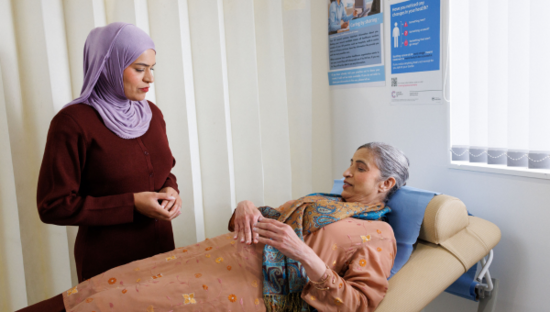NICE (NG12) Suspected Cancer: Recognition & Referral guidelines

Our resources to support you
What are the NICE guidelines for suspected cancer (NG12) and why are they important?
NG12 are national guidelines developed to support primary care in the recognition and referral of suspected cancer. The guidelines are used by primary care professionals in England and Wales.
Using the guidelines in primary care helps ensure people are referred along the right route, at the right time, supporting timelier and earlier cancer diagnosis [1,2].
What do the guidelines cover?
-
Potential cancer signs and symptoms that warrant further investigation
-
Recommendations on the appropriate diagnostic tests for patients
-
How soon diagnostic tests or a consultation should be carried out depending on the signs and symptoms (eg within 48 hours, 2 weeks, etc)
-
Recommendations for safety netting patients
-
Recommendations on information and support for people with suspected cancer and their families and/or carers
NICE include recommendations organised by cancer site, symptoms and the findings of primary care investigations. Read the NICE suspected cancer recognition and referral guidelines (NG12)
Top tips for managing suspected signs & symptoms of cancer
| Follow national guidelines where appropriate, whilst also using your own clinical judgment or gut feeling. Use tools to support you in following the guidelines like our NICE NG12 interactive symptoms guide. Be aware of local guidelines whilst using the tools. | |
|
|
|
|
Use primary care investigations where available at point of care to aid decision-making prior to referral. Check which investigations are recommended in referral guidelines to help prioritise. Chest X-rays, CT scans and blood tests are usually accessible and may help support clinical assessment. If you’re unsure of what’s available to you, contact your practice, ICS or Health Board. |
|
|
Explain to patients that they are being referred on a suspected cancer pathway. Ask your patient if they have any questions. Let them know what to expect at their next appointment and communicate the importance of attending. You can use our Your Suspected Cancer Referral Explained resource to support conversations. |
|
|
For patients presenting with non-specific symptoms, check the availability of non-specific symptom pathways i.e. Rapid Diagnostic Centres (RDCs) in your local area. See our non-specific symptoms webpage for guidance on the referral pathways in each UK nation, and some top tips for managing these patients effectively. |
|
|
Implement robust and consistent safety netting to help manage diagnostic uncertainty. Safety netting is vital for all patients, including those who’ve been referred to secondary care. For those who are managed in primary care, continue to support or investigate until symptoms are explained or resolved. Ensure safety netting systems are set up, actions are recorded and referrals are coded appropriately. Remember to act on clinical suspicion or ‘gut feeling’ if you still have concerns. |
A GP’s perspective
In this video, Cancer Research UK GP Dr Anant Sachdev highlights the importance of routinely using suspected cancer referral guidelines (video recorded March 2022).
Newsletters
Newsletters targeted at health professionals which provide intelligence to support evidence-based decision making and updates on our activities, as well as our bespoke GP newsletter which includes best practice guidance, practical tools and expert resources.
